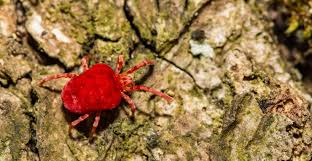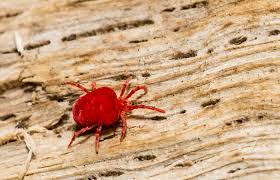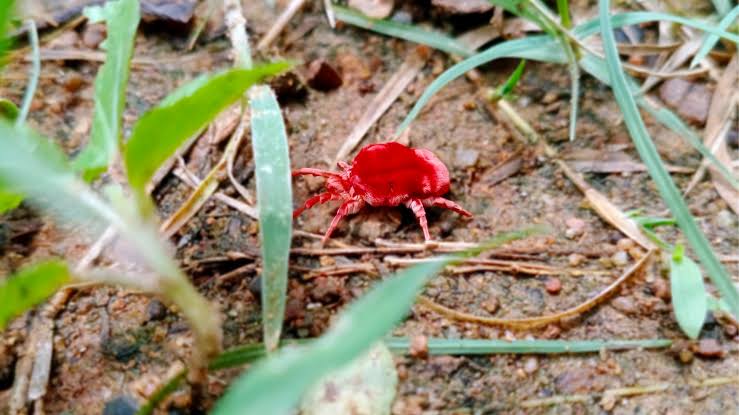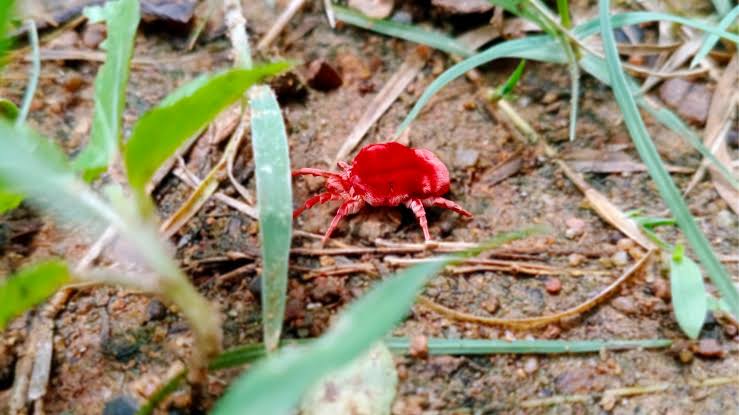Chiggers, scientifically known as Trombiculidae mites, are tiny creatures that may cause discomfort to humans and animals. These minuscule arachnids belong to the family Trombiculidae, and despite their small size, they can create significant irritations.
Chiggers are commonly found in grassy and wooded areas, where they wait for a suitable host to pass by. These hosts can include humans, as well as various mammals, reptiles, and birds. The mites undergo a lifecycle consisting of larval, nymphal, and adult stages, with the larval stage being the one responsible for causing the infamous itching and red welts associated with chigger bites.
When chigger larvae attach to the skin, they inject saliva that contains digestive enzymes, which break down skin cells. This process allows the chiggers to feed on the dissolved cells. The human body’s reaction to these enzymes often results in the formation of red, itchy bumps, known as chigger bites. Contrary to popular belief, chiggers do not burrow into the skin but feed on the skin’s outer layer.
Preventing chigger bites involves taking precautionary measures when venturing into chigger-prone areas. Wearing long sleeves and pants, using insect repellents, and avoiding sitting or lying directly on the ground can reduce the risk of chigger encounters. Additionally, promptly washing and changing clothes after outdoor activities can help remove any lingering chiggers.
If one finds themselves with chigger bites, relieving the itching can be achieved through over-the-counter anti-itch creams or ointments. Scratching the bites should be avoided, as it may lead to secondary bacterial infections.
Understanding the life cycle and habits of chiggers can contribute to better protection against these tiny pests. Although their bites can be bothersome, being aware of preventive measures and practicing them diligently can help individuals enjoy outdoor activities without the nuisance of chigger-induced discomfort.
Read Also: Himalayan Cats (Felis catus) Description and Complete Care Guide
Animals Affected by Chiggers (Trombiculidae mites)

Chiggers, scientifically known as Trombiculidae mites, primarily affect a variety of animals besides humans. These tiny arachnids find hosts across the animal kingdom, causing discomfort through their feeding habits.
1. Mammals: Chiggers commonly infest mammals, including rodents, rabbits, squirrels, and deer. These animals provide a suitable environment for chiggers to thrive in their natural habitats.
2. Birds: Chiggers can also affect avian species. Birds flying or nesting in areas infested with chiggers may become hosts for these tiny mites. However, the impact on birds is less studied compared to their effects on mammals.
3. Reptiles: Though less common, chiggers can infest reptiles such as snakes and lizards. The prevalence might vary depending on the species and their habitat.
4. Amphibians: In certain cases, chiggers have been found on amphibians. Frogs and toads, especially those residing in grassy or wooded areas, may encounter chigger infestations.
5. Domestic Animals: Pets, including dogs and cats, can be affected by chiggers. If these animals roam in areas where chiggers are prevalent, they may get infested, leading to skin irritations and discomfort.
Understanding the range of hosts impacted by chiggers is crucial for implementing preventive measures. Regular grooming, keeping outdoor areas clear of tall grass, and ensuring pets are protected can contribute to reducing the risk of chigger infestations in both humans and animals.
Damages Caused by Chiggers

Chiggers, scientifically known as Trombiculidae mites, can cause several discomforts and irritations due to their feeding habits. While they do not transmit diseases, the damages caused by chiggers are primarily associated with their bites.
1. Itchy Bites: The most common and noticeable damage caused by chiggers is the intensely itchy bites they leave behind. When chigger larvae attach to the skin and inject saliva containing digestive enzymes, it triggers an immune response, resulting in the formation of red, swollen welts. The persistent itching can lead to scratching, potentially causing additional skin irritation.
2. Red Welts: Chigger bites often manifest as small, red welts on the skin. These welts can be distributed in clusters and are commonly found in areas where clothing is tight or in skin folds.
3. Secondary Infections: Scratching chigger bites can break the skin, increasing the risk of secondary bacterial infections. Open wounds provide an entry point for bacteria, potentially leading to complications if proper hygiene measures are not taken.
4. Allergic Reactions: Some individuals may experience allergic reactions to chigger bites, leading to more severe symptoms such as increased swelling, redness, and in rare cases, systemic reactions. Allergic responses can vary from person to person.
5. Discomfort in Animals: Chiggers can also affect various animals, causing similar skin irritations. In pets, for example, chigger infestations may lead to excessive scratching, restlessness, and discomfort.
While the damages caused by chiggers are generally not severe, the persistent itching and potential for secondary infections highlight the importance of preventive measures. Avoiding chigger-prone areas, wearing protective clothing, and using insect repellents can significantly reduce the risk of encountering these tiny pests and the discomfort they bring.
Read Also: Russian Blues (Felis catus) Cats Description and Complete Care Guide
Control and Preventive Measures

Controlling and preventing chigger infestations involves adopting various measures to reduce exposure and minimize the risk of bites. Here are some effective strategies:
1. Protective Clothing: Wear long sleeves, pants, and closed shoes when venturing into chigger-prone areas. Tucking pants into socks or boots can create a barrier, preventing chiggers from reaching the skin.
2. Insect Repellents: Apply insect repellents containing DEET or permethrin to exposed skin and clothing. These repellents can deter chiggers and reduce the likelihood of bites.
3. Avoid Sitting or Lying on the Ground: Chiggers are commonly found in grassy and wooded areas. Avoid direct contact with the ground, especially in tall grasses, to minimize the risk of chigger encounters.
4. Regular Grooming: Shower and change clothes promptly after outdoor activities, especially in chigger-prone environments. This helps remove any unattached chiggers and reduces the chances of bites.
5. Lawn Maintenance: Keep lawns and outdoor areas well-maintained by regularly mowing the grass and clearing debris. This can create an inhospitable environment for chiggers, limiting their presence.
6. Pet Protection: Use pet-friendly insect repellents or consult with a veterinarian to protect pets from chigger infestations. Regular grooming and checking for signs of chiggers can also help in preventing discomfort in animals.
7. Environmental Modifications: Reduce the presence of chigger habitats by trimming overgrown vegetation, clearing brush, and creating a buffer zone between wooded areas and living spaces.
8. Anti-Itch Creams: If chigger bites occur, use over-the-counter anti-itch creams or calamine lotion to alleviate itching. Avoid scratching, as it can lead to secondary infections.
9. Awareness: Be aware of chigger-prone areas and take necessary precautions. Planning outdoor activities with chigger prevention in mind can significantly reduce the risk of encountering these pests.
By combining these preventive measures, individuals can minimize the likelihood of chigger bites and create a more comfortable outdoor experience. Understanding chigger habits and proactively taking steps to avoid them contributes to effective control and prevention.
Frequently Asked Questions (FAQs) About Chiggers (Trombiculidae mites)
1. Q: What are chiggers, and what is their scientific name?
A: Chiggers are tiny arachnids belonging to the Trombiculidae family. Their scientific name is Trombiculidae mites.
2. Q: Where are chiggers commonly found?
A: Chiggers are often found in grassy and wooded areas, especially in tall grasses, weeds, and areas with dense vegetation.
3. Q: Do chiggers burrow into the skin?
A: No, contrary to popular belief, chiggers do not burrow into the skin. They feed on the skin’s outer layer by injecting saliva containing digestive enzymes.
4. Q: What do chigger bites look like?
A: Chigger bites appear as red, itchy welts on the skin. They are commonly found in clusters and may be accompanied by intense itching.
5. Q: Can chiggers transmit diseases?
A: No, chiggers do not transmit diseases to humans. The primary concern is the discomfort caused by their bites.
6. Q: How can I prevent chigger bites?
A: Preventive measures include wearing protective clothing, using insect repellents, avoiding sitting or lying directly on the ground, and practicing good personal hygiene after outdoor activities.
7. Q: What is the lifecycle of chiggers?
A: Chiggers go through a lifecycle consisting of larval, nymphal, and adult stages. The larval stage is the one responsible for feeding on hosts and causing bites.
8. Q: Can pets be affected by chiggers?
A: Yes, pets, including dogs and cats, can be affected by chiggers. Using pet-friendly insect repellents and regular grooming can help protect them.
9. Q: Are chigger bites dangerous?
A: Chigger bites are generally not dangerous but can cause intense itching. Scratching may lead to secondary infections, so it’s essential to avoid excessive scratching.
10. Q: What should I do if I have chigger bites?
A: Use over-the-counter anti-itch creams or calamine lotion to relieve itching. Avoid scratching to prevent potential secondary infections. If symptoms persist, consult a healthcare professional.
Read Also: Low-Maintenance Plants for Beginners

